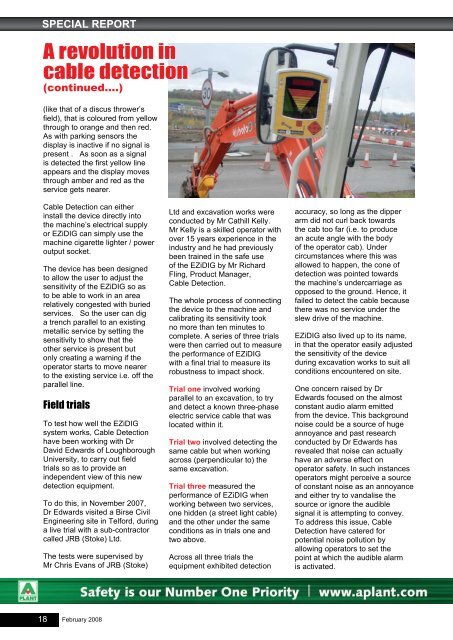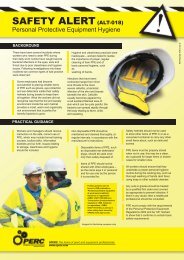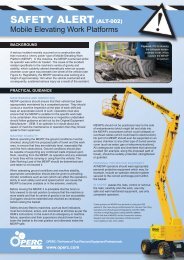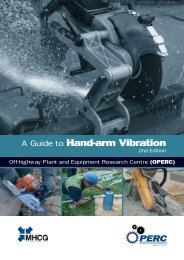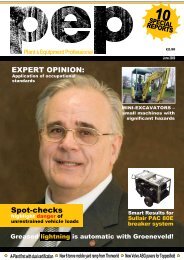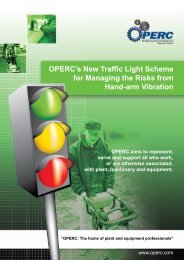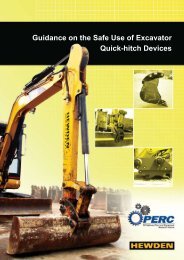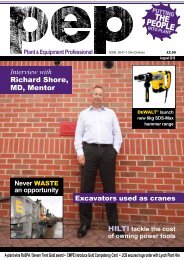Plant&Equipment
Download pdf - OPERC
Download pdf - OPERC
- No tags were found...
Create successful ePaper yourself
Turn your PDF publications into a flip-book with our unique Google optimized e-Paper software.
Special report<br />
A revolution in<br />
cable detection<br />
(continued....)<br />
(like that of a discus thrower’s<br />
field), that is coloured from yellow<br />
through to orange and then red.<br />
As with parking sensors the<br />
display is inactive if no signal is<br />
present . As soon as a signal<br />
is detected the first yellow line<br />
appears and the display moves<br />
through amber and red as the<br />
service gets nearer.<br />
Cable Detection can either<br />
install the device directly into<br />
the machine’s electrical supply<br />
or EZiDIG can simply use the<br />
machine cigarette lighter / power<br />
output socket.<br />
The device has been designed<br />
to allow the user to adjust the<br />
sensitivity of the EZiDIG so as<br />
to be able to work in an area<br />
relatively congested with buried<br />
services. So the user can dig<br />
a trench parallel to an existing<br />
metallic service by setting the<br />
sensitivity to show that the<br />
other service is present but<br />
only creating a warning if the<br />
operator starts to move nearer<br />
to the existing service i.e. off the<br />
parallel line.<br />
Field trials<br />
To test how well the EZiDIG<br />
system works, Cable Detection<br />
have been working with Dr<br />
David Edwards of Loughborough<br />
University, to carry out field<br />
trials so as to provide an<br />
independent view of this new<br />
detection equipment.<br />
To do this, in November 2007,<br />
Dr Edwards visited a Birse Civil<br />
Engineering site in Telford, during<br />
a live trial with a sub-contractor<br />
called JRB (Stoke) Ltd.<br />
The tests were supervised by<br />
Mr Chris Evans of JRB (Stoke)<br />
Ltd and excavation works were<br />
conducted by Mr Cathill Kelly.<br />
Mr Kelly is a skilled operator with<br />
over 15 years experience in the<br />
industry and he had previously<br />
been trained in the safe use<br />
of the EZiDIG by Mr Richard<br />
Fling, Product Manager,<br />
Cable Detection.<br />
The whole process of connecting<br />
the device to the machine and<br />
calibrating its sensitivity took<br />
no more than ten minutes to<br />
complete. A series of three trials<br />
were then carried out to measure<br />
the performance of EZiDIG<br />
with a final trial to measure its<br />
robustness to impact shock.<br />
Trial one involved working<br />
parallel to an excavation, to try<br />
and detect a known three-phase<br />
electric service cable that was<br />
located within it.<br />
Trial two involved detecting the<br />
same cable but when working<br />
across (perpendicular to) the<br />
same excavation.<br />
Trial three measured the<br />
performance of EZiDIG when<br />
working between two services,<br />
one hidden (a street light cable)<br />
and the other under the same<br />
conditions as in trials one and<br />
two above.<br />
Across all three trials the<br />
equipment exhibited detection<br />
accuracy, so long as the dipper<br />
arm did not curl back towards<br />
the cab too far (i.e. to produce<br />
an acute angle with the body<br />
of the operator cab). Under<br />
circumstances where this was<br />
allowed to happen, the cone of<br />
detection was pointed towards<br />
the machine’s undercarriage as<br />
opposed to the ground. Hence, it<br />
failed to detect the cable because<br />
there was no service under the<br />
slew drive of the machine.<br />
EZiDIG also lived up to its name,<br />
in that the operator easily adjusted<br />
the sensitivity of the device<br />
during excavation works to suit all<br />
conditions encountered on site.<br />
One concern raised by Dr<br />
Edwards focused on the almost<br />
constant audio alarm emitted<br />
from the device. This background<br />
noise could be a source of huge<br />
annoyance and past research<br />
conducted by Dr Edwards has<br />
revealed that noise can actually<br />
have an adverse effect on<br />
operator safety. In such instances<br />
operators might perceive a source<br />
of constant noise as an annoyance<br />
and either try to vandalise the<br />
source or ignore the audible<br />
signal it is attempting to convey.<br />
To address this issue, Cable<br />
Detection have catered for<br />
potential noise pollution by<br />
allowing operators to set the<br />
point at which the audible alarm<br />
is activated.<br />
18<br />
February 2008


